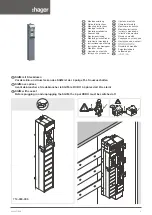
3. Installation guidelines
warranty null and void. In such a case the client shall be held solely responsible for all costs incurred during any repair. It is the
clients responsibility to ensure at all times that the projector is protected from the harmful effects of hostile airborne particles in the
environment of the projector. The manufacture reserves the right to refuse warranty repair if a projector has been subject to wantful
neglect, abandon or improper use.
What about ambient light ?
The ambient light level of any room is made up of direct or indirect sunlight and the light
fi
xtures in the room. The amount of ambient
light will determine how bright the image will appear. So, avoid direct light on the screen. Windows that face the screen should be
covered by opaque drapery while the set is being viewed. It is desirable to install the projection system in a room whose walls and
fl
oor are of non-re
fl
ecting material. The use of recessed ceiling lights and a method of dimming those lights to an acceptable level
is also important. Too much ambient light will ‘wash out’ of the projected image. This appears as less contrast between the darkest
and lightest parts of the image. With bigger screens, the ‘wash out’ becomes more important. As a general rule, darken the room to
the point where there is just suf
fi
cient light to read or write comfortably. Spot lighting is desirable for illuminating small areas so that
interference with the screen is minimal.
Which screen type ?
There are two major categories of screens used for projection equipment. Those used for front projected images and those for rear
projection applications. Screens are rated by how much light they re
fl
ect (or transmit in the case of rear projection systems) given a
determined amount of light projected toward them. The ‘GAIN’ of a screen is the term used. Front and rear screens are both rated
in terms of gain. The gain of screens range from a white matte screen with a gain of 1 (x1) to a brushed aluminized screen with a
gain of 10 (x10) or more. The choice between higher and lower gain screens is largely a matter of personal preference and another
consideration called the Viewing angle. In considering the type of screen to choose, determine where the viewers will be located
and go for the highest gain screen possible. A high gain screen will provide a brighter picture but reduce the viewing angle. For
more information about screens, contact your local screen supplier.
Image size
The projector is designed for projecting an image size with a screenwidth from 1.00m (3.3ft) to 6.00m (19.7ft) with an aspect ratio of
16 to 9.
3.3
Projector position
C
AUTION
:
Improper positioning of the projector may reduce the lamp life and result in severe accident or
fi
re
hazard.
Projector Position
Keep following projector position guidelines in mind when installing the projector:
10
R59770247 SIM 5H 04/06/2008
Summary of Contents for SIM 5H
Page 1: ...Sim 5H Owner Manual R9040390 R59770247 00 04 06 2008...
Page 4: ......
Page 8: ...Table of contents 4 R59770247 SIM 5H 04 06 2008...
Page 10: ...1 Safety Instructions 6 R59770247 SIM 5H 04 06 2008...
Page 18: ...3 Installation guidelines 14 R59770247 SIM 5H 04 06 2008...
Page 48: ...6 Getting started 44 R59770247 SIM 5H 04 06 2008...
Page 79: ...7 Advanced Image 7 59 Image 7 60 Image 7 61 R59770247 SIM 5H 04 06 2008 75...
Page 166: ...7 Advanced 162 R59770247 SIM 5H 04 06 2008...
Page 170: ...Index 166 R59770247 SIM 5H 04 06 2008...
Page 172: ...List of tables 168 R59770247 SIM 5H 04 06 2008...















































